The common txantxiku, a responsible parent
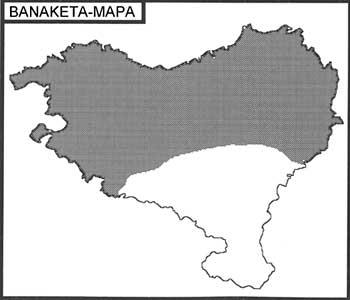
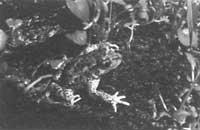
The common txantxiku (Alytes obstetricans) is a small poplar, toad shaped cap, but without parotoid glands, with a length of 4,2-4,6 cm. From end to year. The lateral eyes are very visible in the dorsal area, with golden or silver irises dotted with black and vertical beginini. This last feature is very suitable for identifying the skewer. In fact, among the amphibians of Euskal Herria the txantxikua is the only one with vertical beginini.
Rough skin in the dorsal area and granular in the ventral. As for coloration, it can be very variable in general, predominating in the dorsal face the gray or brown colors (sometimes yellow-greenish, dark or lighter). The ventral part can be light grey, white or yellowish, without scars.
The activity of this amphibian begins at dusk and is maintained during the night. During the day, and unless it rains, it remains hidden under trees or stones, in natural or artificial inks, in tiles, in mines and caves. This behavior should be understood as an ethological adaptation related to the animal's need to maintain moisture. In fact, outside the mountainous regions this small discoglove is hardly visible and does not appear in arid habitats.
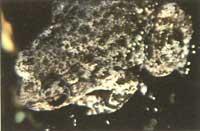
It is often found in gardens and other human constructions, such as railway edges, street edges, etc. As an example, in the railroads of Deusto, in Bilbao, we have been able to see in recent years a strong and sustainable population, and in full time (from March to October) you can hear almost every day the song of the txantxiku. This song is a soft musical pip, similar to that made by the vulture (Otus scopsa), which is perceived mainly at the first hour of sunset and night.
Txantxikua is a predator whose prey is small insects, worms and bumps. On the other hand, it also has defenses to escape the enemies that hunt it: on the one hand, the cryptic coloring of the gull makes invisible to many of the possible enemies, and on the other, and as happens in many amphibians, the skin is endowed with poisonous glands. The toxins that can be released have a garlic smell and, therefore, the txantxiku itself is also on many occasions.

This animal is a terrestrial amphibian that only approaches the water in full time. As a result of this dry trend, and in order to allow it, txantxiku has suffered a series of adaptations in its ethology and its reproduction model. The most striking aspect of its biology is that of reproduction, which differs from any other amphibian. The txantxiku does not lay the eggs in the water, but the male, the fecundated eggs on the ground, drags them stuck by the back legs until the hatching occurs.
The laying and fertilisation are produced as follows: if the female is found, the male catches with broad lumbar, that is, it climbs on the back of the female and, using the front legs, holds the female ahead of the rear legs. Then, with the back legs, strike rhythmically and rub the clone of the female, repeating the movement again and again. The total duration of the process is 40-90 minutes. Then, with the back legs it crushes the cloaca of the female, with the legs almost to the same, until it gets rid of 20 to 100 eggs a little parpadeados.
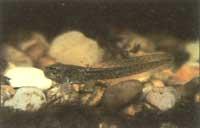
The eggs so laid are conditioned for dry development and, unlike most of the anurs, a chamber of liquid capsular is developed around each egg, immediately after its laying. This capsular chamber makes of water deposit avoiding the dehydration of the egg. The eggs, on the other hand, are wrapped in a long cap and are removed forming a cord. At that time the fertile male (for which an external fertilization occurs) and after a small break begins to clog in the back legs the cord formed by eggs, until it organizes them forming a branch on the pelvic waist.
Carrying the eggs in the back does not seem to alter the behavior of the male, nor cause discomfort. What's more, taking care of the eggs only requires a job for the male, that is, that every night water is sought and that the eggs remain introduced in it for some time so that their capsular chambers are filled.
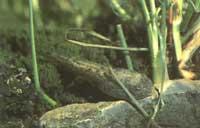
The duration of embryo development depends on the temperature and can be extended between 24 and 44 days. Once the embryos have been developed and taking advantage of the nocturnal launching, an hatching occurs in which the larva (tadpoles) starts a free aquatic life. When it detects that the first hatchings occur, the male releases a lot of eggs in the water.
Newly hatched gray hair usually has a length of 14-17 mm and can reach 40-80 mm after a few months. The development of these dunes is usually 2-3 months, and the adult txantxiku that forms after metamorphosis has a length of 20-25 mm. However, the duration of the larval development and metamorphosis depends on the external conditions, and when the climatic conditions are inadequate, a hibernation of the tadpoles can occur, prolonging the duration of the metamorphosis up to one year. As an extreme example, it has been shown that the age of the tadpoles found in a river located at 2,400 m in the Pyrenees was 20 years!
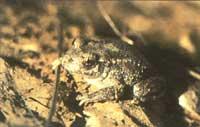
The common txantxiku is found in Europe in the southwestern region and in Africa in Morocco. However, and below the center of the Iberian peninsula, it has only been observed in mountainous areas with altitudes greater than 1.000 m.
As for the Basque Country, and due to its humid climate, it can be said to be found practically throughout the territory, except in the south of Navarre. In fact, the ease with which this amphibian benefits from any type of resource has allowed it to adapt to a wide variety of habitats. Therefore, the species has solid populations in the Basque Country and its sustainability does not seem to be in danger.

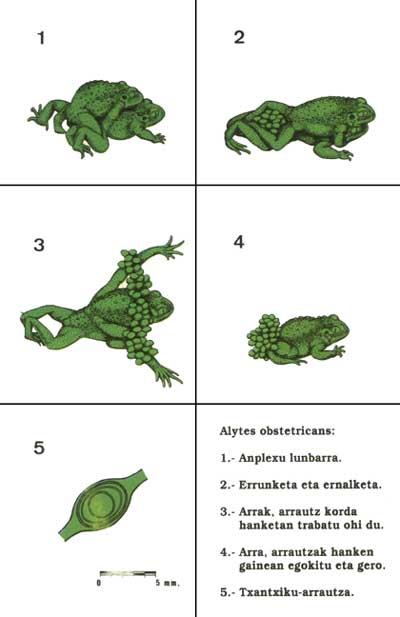
TECHNICAL SHEET: COMMON SKEWER |
SPECIES: ObstetricansFAMILY: DISCOGLOSSIDAEORDEN: ANURACLASE: AMPHIBIA |





